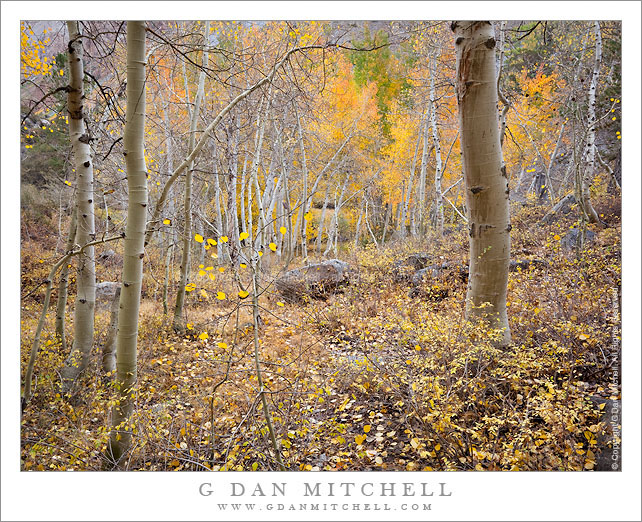Aspen Grove, North Lake Road. Sierra Nevada, California. October 3, 2010. © Copyright G Dan Mitchell – all rights reserved.
Fallen leaves in an aspen grove along the road to North Lake, Sierra Nevada, California.
This photograph of a grove of large and small aspens with much undergrowth and fallen leaves was made on a morning of beautiful soft and diffused light as a weather front was moving in and light rain was starting. In this light the harsh highlights of the bright leaves are softened and the shadows open up (since the sky becomes one giant light box) so that details become more apparent and the colorful trees and leaves can almost glow.
This grove is beside a road used by many photographers to get to one of the most popular and iconic fall color locations in the eastern Sierra. As I worked alone, or nearly so, in this small grove on a gentle hillside, five minutes up the road perhaps 50 or 60 photographers were lined up side by side at the end of a lake to make the same photograph. In fairness, the subject of their photographs is a very beautiful and compelling one… but I urge photographers to look beyond the “same old, same old,” and to slow down and search out subjects and compositions that only become apparent with time and some contemplation.
This photograph is not in the public domain and may not be used on websites, blogs, or in other media without advance permission from G Dan Mitchell.
G Dan Mitchell Photography | Twitter | Friendfeed | Facebook | Facebook Fan Page | Email
Discover more from G Dan Mitchell Photography
Subscribe to get the latest posts sent to your email.


Good thoughts, Greg. There are several general ways to “see” something that isn’t the same as all the other photographs, and probably more than I can think of right now….
1. Go to locations that other photographers have not yet “worked.”
2. Look at aspects of familiar subjects that others have not yet “seen.”
3. See out unusual and special conditions.
4. Think of new ways to approach familiar subjects – people in the frame? animals? different lenses? Application of post-processing techniques? Camera position?
5. Look “around the edges” of the familiar scenes. Go to one of the icon locations, but instead of shooting the whole giant thing, work some of the small details.
6. others?
Dan
Dan – I concur fully with your last sentence in looking beyond the obvious to find subject matter. There are some spectacular events in nature that no one should miss, even if there is a glut of photographers present. However if one is to put their own, unique stamp on an image, one will have to go to locations that are either less visited, and/or pray for climatic conditions that yields unusual lighting conditions.
My favorite personal images are not the images I have taken at iconic locations (although I confess a few are hanging up on my walls), but the rare images that I have found, where others have found nothing, and generally have overlooked.
The funny thing is I have a difficult time prediciting where these serendipitous confluences of light and subject matter might occur. One finds it where one finds it. One usually has to hedge one’s bets and travel to an iconic location, but perhaps the great shot that morning could have been a simple stand of trees out behind the gas station that one passed at Tom’s Place, but didn’t give them a second thought at the time as one was making a beeline towards Bishop.
I think that is one of the fascinating things about nature photography, because depending on the lighting, and the subject matter, any area could yield a “gold mine”, and one that might pay off for years by returning personally gratifying images.